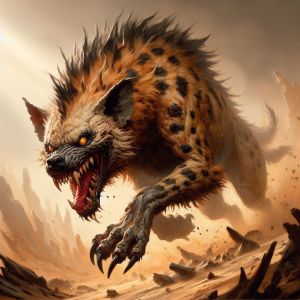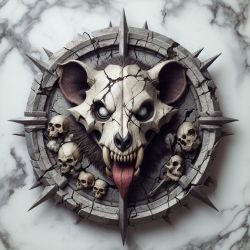Kharn

Kharn, the deity of hate, is the embodiment of ferocity and cruelty. His personality is unrefined, primal—fueled by the raw, unfettered essence of hate. Simple in his malevolence, Kharn eschews the complexities of strategy, diplomacy, and understanding, preferring the brutal honesty of direct confrontation. His hatred burns fiercely, particularly aimed at the higher, more civilized beings, whose ordered existence he despises.
Drawing energy from the chaotic passions of hate, Kharn aligns himself with the savage humanoid races, for whom primal behavior and violence are second nature. These tribes, resonating deeply with his cruel intentions, serve as perfect vessels for his divine will, propagating his malevolent influence through their deeds.
Kharn's realm is the battlefield, a vast, endless expanse where power is the only currency and onslaught the only strategy. He sees the world as a place to conquer, urging his followers to seize by brute force anything they desire. His call to arms is simple yet brutal: take what you believe is rightfully yours, and do so through ruthless, bloody conflict.
Endurance is woven into the fabric of his divine essence, as he understands well the resilience required by those who walk the path of hate. His followers are thus hardened by the trials and tribulations of their existence, embodying the endurance necessary to thrive in a world that pushes back against their relentless advance.
In this way, Kharn's influence spreads across the cosmos—a dark tide of hate and destruction that challenges the very foundations of order and civilization, proving him a relentless force in the eternal battle for dominance and survival.
Kharn shows himself as a formidable orcish humanoid, blending the fierce attributes of both orc and hyena in his feral visage. His face, permanently contorted into an expression of intense hatred, is framed by a long, grayish beard and hair, adding to his wild appearance. His muscular upper body, left bare, showcases an intricate array of dark tribal tattoos, emphasizing his savage and mystical nature. His attire consists solely of rugged leather orcish pants and sturdy iron boots, which complements his fearsome and battle-ready demeanor. This appearance perfectly encapsulates his role as the deity of hate, exuding power, ferocity, and an unbridled primal spirit. Kharn also shows himself in the guise of a feral hyena of wild and unkempt fur and menacing gaze.
Symbol
Kharn's symbol is a menacing visage, centered by a hyena skull with a predatory grin and piercing eyes, accentuated by a tongue lolling out in a grotesque display of thirst for mayhem. Encircling this are smaller skulls and jagged spikes, amplifying the aura of brutality and defiance. This emblem embodies Kharn’s essence—unrelenting hatred and cruelty, a rallying call to his followers to embrace the chaos and destruction he reigns over.
Relations With Other Deities
Kharn, the deity of hate, stands as a formidable figure among both evil and good pantheons, known for his brazen forays beyond the typical boundaries of evil's reach. His minions, spread far and wide, sow seeds of chaos and destruction in regions seldom touched by other dark deities. This widespread influence and his brutal, direct approach make Kharn a feared adversary among the celestial realms.
The gods of good, particularly those like Elandrien, the deity of the woodlands, and Dunguthar, the deity of mining and stoneworking, view him with enmity and actively combat his followers' incursions. These gods hold a special contempt for Kharn, as he bitterly claims rights over lands they protect, lands he sees as anciently his by forgotten conquests.
Amongst neutral deities, opinions vary. The more civilized among them dismiss him as a mere disruptor, a chaotic element unsettling the balance. However, deities like Dorgross, who value strength and rawness, find a certain respect for Kharn’s unpolished and fierce demeanor.
Within the dark corridors of the pantheon of dread, Kharn is valued as a strategic asset. His ability to command legions of potent, though easily swayed, minions provides a crucial distraction for the forces of good. This relentless assault allows his darker brethren to craft more sinister schemes undisturbed. Obedient to Tiamat’s commands, Kharn relishes the freedom this alliance grants him, freedom to fuel his wrath against those he despises and enabling his relentless pursuit of vengeance and destruction.
What The Legends Say
This is in a state of significant expansion or restructuring We hope we can have this content ready soon. |
Dogma

Kharn's dogma is based on these five tenets:
- Embrace the Hatred: Kharn's followers must embrace hatred as a powerful force, channeling it to drive their actions and fuel their conquests. Hatred is not just an emotion but a source of strength that empowers them to overcome obstacles and crush their foes.
- Pursue Vengeance Relentlessly: Devotees of Kharn are compelled to pursue vengeance without mercy or hesitation. Any slight or wrong must be answered with swift and brutal retribution, reflecting Kharn’s eternal thirst for vengeance against those who oppose him.
- Impose Yourself by Force: In honoring Kharn, followers are expected to assert their dominance through acts of violence and intimidation. Massacres and displays of power are rituals that spread fear and destruction, serving both as a testament to their deity's might and a method of worship.
- Resilience in the Face of Hatred: Followers must not only survive but thrive amid opposition and hostility. This tenet underscores the belief that enduring hardship and harnessing the path of hate leads to true power and supremacy.
- Reject the Illusions of Peace and Order: Kharn’s followers must actively oppose any forms of peace and order that suppress their primal instincts. They are encouraged to disrupt societal constructs, demonstrating their allegiance to Kharn by dismantling anything that impedes their brutal objectives.
Clergy and Temples

Kharn's clergy is a formidable and tribal group, embodying the chaotic and ruthless essence of their deity. Organized into small, autonomous cells, these clerics operate independently across various regions, reflecting the decentralized nature of a faith driven by the raw energies of hate and vengeance. Within each cell, leadership is not determined by formal titles or structured hierarchy but by sheer force and charisma. The leader is typically the most powerful or feared individual, commanding respect—or more often, fear—from their followers.
The followers of Kharn are drawn from a diverse array of races, predominantly from those considered savage such as orcs, ogres, and goblinoids. However, the ranks also include members of more common races like humans, who share a ruthless disposition and a proclivity towards a savage lifestyle. This eclectic congregation is united under Kharn’s banner, with warriors and warlocks being the most prevalent classes, channeling the destructive will of their deity through physical prowess and dark magic.
In appearance, Kharn’s clerics are as intimidating as the deity they worship. They dress in rugged garments designed to instill fear and assert dominance. Adorned with symbols of war and bloodshed, such as skulls and spikes, their attire often features dark tones of red and black, representing blood and the darkness of their deeds. Hooded cloaks are common, adding an air of mystery and menace, and they sometimes wear light armor, enhancing their fearsome visage without sacrificing mobility.
The behavior of Kharn’s clergy is aggressively assertive, with disputes among them or with outsiders typically resolved through displays of force. This aggressiveness extends beyond personal interactions to their role within the larger society. Despite their savage nature, they possess a significant strategic value. Their ability to gather and lead warbands of similarly savage races makes them useful tools for those with malevolent intentions. Evil masterminds and cunning villains often exploit these clerics to amass armies of easily manipulable minions, furthering dark agendas and sowing chaos.
However, the very traits that make Kharn’s clergy valuable to the nefarious also make them feared and shunned by general society. Their brutal methods and the inherent chaos they bring mark them as harbingers of conflict, unwelcome in civilized areas. They are often regarded with a mix of fear and disdain, seen as a necessary evil at best and a dangerous plague at worst. This isolation reinforces their fierce loyalty to Kharn and each other, driving them deeper into the shadows from which they strike at the world that has cast them out.
Kharn's worship is rooted deeply in savagery and the transient nature of his followers, who are often part of nomadic warbands or reside in remote, small villages on the fringes of civilization. This mobile and rugged lifestyle is reflected in the sacred spaces they consecrate to Kharn, which are far from the established temples seen in more settled religions.
Instead of grand temples, the followers of Kharn create makeshift shrines within shaman tents or rudimentary huts. These sacred spaces are crafted from materials readily available in their environment, often camouflaged into the landscape, and are as mobile as the warbands themselves. The design of these shrines is a direct reflection of Kharn's brutal and direct nature.
The decoration within these sacred spaces mirrors the adornments seen on the clerics themselves—symbols of war and conquest such as skulls, spikes, and bones are common. These totems of power are not just decorative but are imbued with shamanistic significance, each piece a trophy from past battles or a ward believed to carry protective energies. Handcrafted shields and weapons are often placed strategically around the interior, serving both a functional and ceremonial purpose.
The interior of a Kharn shrine is uncomplicated, designed for the practical needs of ritual and worship. At the center lies a simple altar, used for offerings and occasionally sacrifices, which are made to invoke the deity’s favor or seek guidance before a raid or battle. This altar is often stained with the remnants of blood offerings, a stark testament to the grim appeasements preferred by Kharn’s followers.
Despite their simplicity, these shamanic huts are charged with the raw, primal energy of Kharn. They serve as focal points for the spiritual life of the warband, hosting rituals that reinforce the bonds between the members and their ruthless deity. There is no need for hidden vaults or secret chambers; everything in Kharn's worship is as straightforward and exposed as the brutal tenets of their faith.
Initiation
In the rugged and untamed reaches where Kharn's influence pervades, the initiation into his worship is a pivotal rite of passage for the young members of savage humanoid tribes. It begins when a community member, a year shy of coming of age, approaches a shaman or cleric to request initiation. This moment marks the transition from youth to the cusp of adulthood, and the ceremony is interwoven with the tribe's traditions of maturity and belonging.
From this point, the initiate's life changes significantly. They begin to partake in the adult responsibilities of the tribe, such as hunting, engaging in combat training, and joining raids. These activities are not only essential for survival and defense but also serve as practical applications of Kharn's brutal dogma—each act a reflection of strength, ferocity, and the relentless pursuit of dominance.
Throughout this year of transformation, the initiate dedicates an hour each day to meditation. Secluded and introspective, they reflect on their daily experiences, contemplating how their actions align with the teachings of Kharn. This daily practice deepens their understanding of the deity’s ethos, embedding the virtues of strength and vengeance into their very being.
As the year concludes, the initiate observes a day of profound solitude. This is a day of introspection and self-assessment, where they ponder the entirety of the year's deeds and their spiritual journey under Kharn's shadow. It is a crucial period for embracing the savage deity’s teachings fully and preparing mentally and spiritually to serve him without reservation.
The culmination of this initiation occurs at dusk on the following day, in a ceremony steeped in symbolism and witnessed by the entire community. Gathered around a ritual fire that casts flickering shadows on eager faces, the tribe watches as the initiate steps forward to complete their passage into full adulthood and spiritual awakening.
In the flickering light of the communal fire, the shaman or cleric approaches the initiate, drawing a blade across the young warrior’s forearm. The cut, while superficial, is significant, allowing blood to flow freely as a symbol of their readiness to bleed for Kharn. The initiate then holds their arm over the fire, letting drops of blood sizzle and evaporate in the flames, an offering of their essence to the deity of hate and vengeance.
With solemn gravity, the cleric dips a finger into the blood and traces the tribe's symbol on the initiate's forehead. As he marks the skin, he prays aloud, invoking Kharn’s favor and acceptance of this new follower into his fold. The ritual concludes with the casting of an initiation spell, sealing the initiate's fate as a devotee of Kharn and a fully-fledged adult of the tribe.
This initiation, while stark and severe, is a celebration of survival, strength, and the fierce loyalty that Kharn’s followers uphold. It reinforces the bonds within the community and cements the initiate’s place both within their society and under the watchful, ruthless gaze of Kharn.

